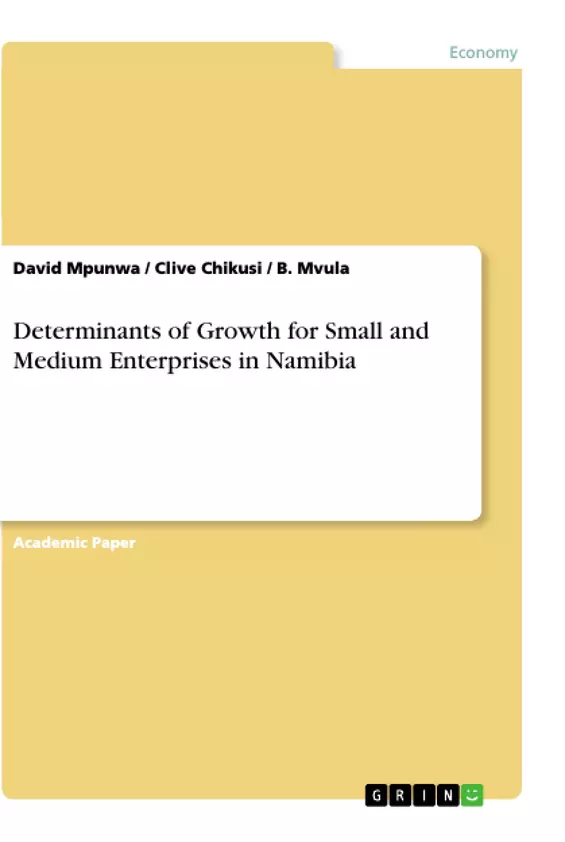SMEs are still incertitude in their quest to run their business effectively. These compunctions are lack of access to finance, lack of access to market, lack of growth, poor education, lack of family support and poor business skills. All these determinants hamper the SMEs, which ultimately leads to their failure. Globally, SMEs are engines of expansion because they play a strategic role in poverty alleviation, job creation and wealth provision of regional equilibrium through industrial dispersal and reduction of rural-urban migration. We argue that if much had been done by State to promote SMEs, then the rate of unemployment would be one digit, not two digits in Namibia. The ease of making business in Namibia is appalling rated by WHO as an environment which does not promote and not easy to enhance SMEs growth. The regulatory environment for SMEs is very challenging. There are so many prohibiting procedures for starting a business as a local and foreigner.
The overall research design of this rubric entailed a survey research method and drew from the procedures for researching small tourism businesses in Katima Mulilo. We made cross-sectional study and involved a sample of 14 entrepreneurs that was got between March 2017 and August 2018. Status of growth for Katima Mulilo shows that 0-2% have 10% growth, while 20% had 3-4% growth, 60% of the SMEs had average growth 5-9%. The remaining 20% had high growth of 10-25% status of growth in the company. The component score coefficient matrix shows factor component loadings using the principal component analysis. The factor loadings for individual characteristics, social determinants, poor business location and poor financial management, are very low symbolising that they are poor while human capital and planning and ordaining are higher than 0.40. They are symbolising that they are moderately below par. The principal component analysis is a variable reduction analysis and vital for checking redundancy for the figures. Factor analysis in this study assumes that covariation among the observed variable is due to the presence of one or more latent variables which exert directional influenced observed variables. We recommend that the government should have a National Entrepreneurship Policy Framework and Implementation Guideline and put in place an Entrepreneurial Act to promote Entrepreneurs in the Country.
Inhaltsverzeichnis (Table of Contents)
- Abstract
- 1 INTRODUCTION
- Delineation of SMEs
- Theories of Entrepreneurship
- Determinants leading to Success or Failure of SMEs
- Causes of the failure of SMEs
- Growth strategy
- Technology adoption
- Entrepreneurship Development Programs
- Extrinsic determinants
- Challenges of SMEs
- Entrepreneurial differentia
- Marketing
- 3. METHODOLOGY
- Research Design
- 4 Discussion of Findings.
- Demographic Variables for the Sample
- The determinants that affect the growth development of SMEs.
- Access to finance
- Bootstrapping
- Angel Investors
- Venture Capitalists
- The determinants contributing to the growth of your tourism SMEs in Katima Mulilo?
- Marketing the SMEs
- 2Human Resource Management
- Financial growth Determinants
- ICT growth Determinants
- Operations growth Determinants
- Determinants which enhance business success
- Strategies most important in enhancing performance in your SMEs
- Policy Recommendations
- Bibliography
Zielsetzung und Themenschwerpunkte (Objectives and Key Themes)
The study aims to explore the factors that influence the growth of Small and Medium Enterprises (SMEs) in Namibia, with a particular focus on the tourism sector in Katima Mulilo. The authors seek to understand the challenges and opportunities faced by these enterprises, as well as the key determinants that contribute to their success or failure.
- Determinants of SME growth in Namibia
- Challenges faced by SMEs in Namibia, particularly in the tourism sector
- The role of access to finance, marketing, human resource management, and technology in SME growth
- Policy recommendations for promoting SME growth in Namibia
- Analysis of SME growth in Katima Mulilo
Zusammenfassung der Kapitel (Chapter Summaries)
The study begins with a detailed introduction outlining the critical role of SMEs in economic growth and the challenges they face. The introduction highlights the global contribution of SMEs to economic development and provides specific examples of their significance in the tourism sector, particularly in Europe. The chapter emphasizes the importance of understanding the determinants of SME growth in order to implement policies and strategies that promote their success.
The second chapter presents a comprehensive literature review, exploring various theories of entrepreneurship and the factors that can contribute to the success or failure of SMEs. The chapter also delves into specific challenges faced by SMEs, including access to finance, marketing, technology adoption, and human resource management.
The third chapter focuses on the methodology used in the study, outlining the research design and sample selection process. The chapter also discusses the data collection methods employed, providing specific details about the survey research conducted.
The fourth chapter presents the findings of the study, examining the demographic characteristics of the sample and exploring the various determinants that affect SME growth in Katima Mulilo. The chapter analyzes the impact of access to finance, marketing strategies, human resource management practices, and technology adoption on SME growth, offering insights into the key factors that contribute to the success of these enterprises.
Schlüsselwörter (Keywords)
The study primarily focuses on the determinants of growth for small and medium enterprises (SMEs) in Namibia, with a specific emphasis on the tourism industry. Key terms and concepts include SME growth, access to finance, marketing strategies, human resource management, technology adoption, entrepreneurial differentia, and policy recommendations for promoting SME success in Namibia.
- Quote paper
- Prof. David Mpunwa (Author), Clive Chikusi (Author), B. Mvula (Author), 2020, Determinants of Growth for Small and Medium Enterprises in Namibia, Munich, GRIN Verlag, https://www.grin.com/document/535364



